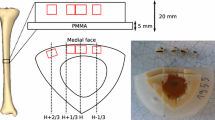Abstract.
Studies have indicated that quantitative ultrasound (QUS) variables may be influenced by the mechanical properties of bone which in turn are determined by bone's material and structural properties. However, from these studies it is unclear what role density, elasticity, and structure play in determining velocity. Eighteen defatted, 12-mm cubic trabecular bone specimens were cut from cadaveric specimens. Amplitude-dependent speed of sound (SOS) using a single point QUS system was assessed in three orthogonal axes. Magnetic resonance images were obtained, from which measures of apparent trabeuclar structure were derived. The specimens were nondestructively tested in compression along three orthogonal axes defined by the sides of the cubes. The elastic modulus (in the three directions) and the strength (in one direction) were determined. Trabecular BMD was measured by quantitative computed tomography. SOS varied significantly with direction of measurement, with the highest value in the axial direction (axial:1715 m/s, sagittal: 1662 m/second, and coronal: 1676 m/s). SOS of each of the three axes was generally associated with the various mechanical (r = 0.30–0.87), density (r = 0.81–0.93), and bone structural variables (0.3–0.8). However, after adjusting the SOS correlations by density, only the correlation with elasticity remained significant in the coronal direction. BMD alone explained 88–93% of variance in SOS whereas in the multivariate model, BMD plus elasticity and/or anisotropic variables explained 96–98% of the variance in SOS. Variability of SOS is explained mostly by density and to a small extent by elasticity or anisotropy. Since only 2–6% of the variance of the QUS measurement is not explained by density and elasticity, one could conclude that the remaining variance reflects other properties of bone or perhaps simply measurement error. Evidence that these other properties may be structure related is only found in the anisotropy of QUS parameter.
Similar content being viewed by others
Author information
Authors and Affiliations
Additional information
Received: 15 October 1997 / Accepted: 8 April 1998
Rights and permissions
About this article
Cite this article
Hans, D., Wu, C., Njeh, C. et al. Ultrasound Velocity of Trabecular Cubes Reflects Mainly Bone Density and Elasticity. Calcif Tissue Int 64, 18–23 (1999). https://doi.org/10.1007/s002239900572
Published:
Issue Date:
DOI: https://doi.org/10.1007/s002239900572




